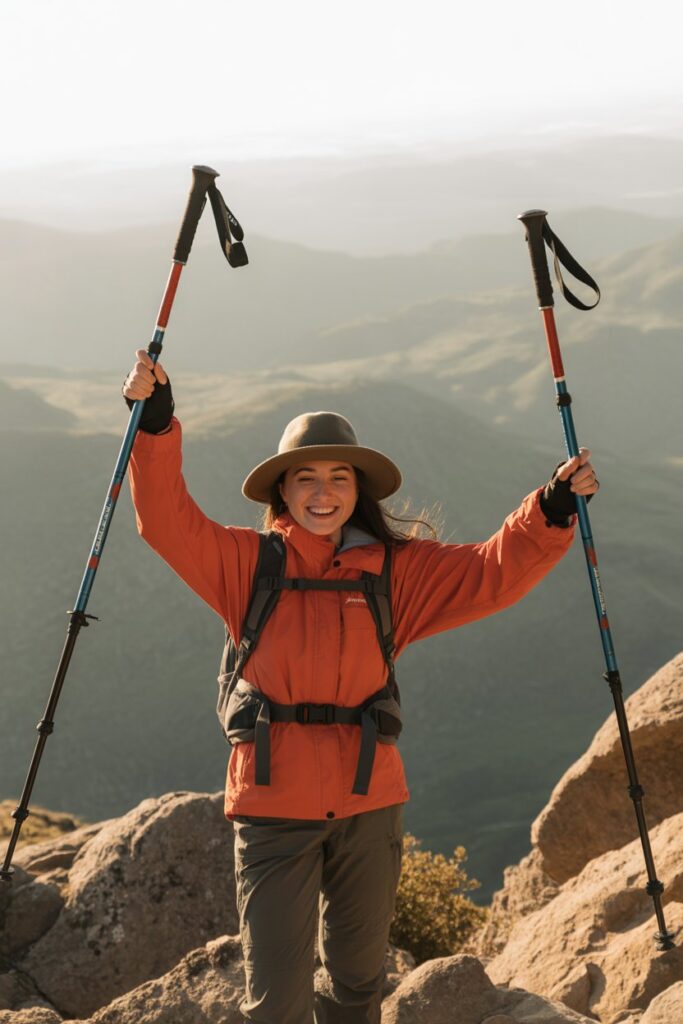If you’ve ever seen hikers swinging down a trail with two poles in hand and wondered, “Are they skiing without snow?” — you’re not alone. Trekking poles can look a little intense if you’ve never used them. But once you try them, you’ll quickly realize they’re not just for “serious” mountaineers.
In fact, using trekking poles can completely change how your body feels during and after a hike. Whether you’re strolling through your local park, tackling a steep summit, or carrying a heavy pack on a multi-day trek, walking with trekking poles can make the journey smoother, safer, and a lot more enjoyable.
This guide will walk you through why trekking poles are worth it, how to use them properly, and how to avoid the rookie mistakes that can make them feel awkward. By the end, you’ll know exactly how to adjust, hold, and walk with trekking poles like you’ve been doing it for years.
The beauty of trekking poles is that they’re versatile enough for almost any type of hiker. If you’re new to hiking, they give you a reassuring extra point of contact with the ground — perfect for building confidence on trickier sections of trail. If you’re an experienced backpacker carrying a heavy pack, they help distribute weight more evenly so your legs don’t do all the hard work. And if you’re somewhere in between (hello, weekend warriors), you’ll find that using trekking poles simply makes every step feel lighter and more efficient.
Plus, they’re not just for climbing steep inclines or surviving rocky descents. Even on flat, easy trails, walking with trekking poles keeps your rhythm steady and your stride comfortable. Think of it like having a little boost of forward momentum with every step — the hiking equivalent of a tailwind.
In this guide, we’ll cover everything you need to know about trekking poles: how to choose them, adjust them, and use them effectively on different types of terrain. We’ll also look at the common mistakes that make poles feel awkward and how to avoid them, so you can hit the trail with confidence. By the time you’re done reading, you’ll know exactly how to walk with trekking poles like you’ve been doing it for years — without the trial-and-error phase most beginners struggle through.
Why Using Trekking Poles Is Worth It
Let’s be honest — most people only try trekking poles because their knees started complaining. But the benefits go way beyond joint relief. Using trekking poles changes how your whole body moves on the trail.
Here’s what they give you:
- Better balance on uneven, rocky, or slippery terrain
- Less pressure on knees and ankles during descents
- More power when climbing steep sections
- Improved posture on long hikes
- Extra support when carrying a heavy backpack
Even if you hike only once a month, these little advantages add up quickly.
Walking with Trekking Poles on Different Terrain
Not every trail is the same — and that’s exactly why trekking poles shine.
- Flat trails – Keep a steady rhythm and reduce arm fatigue.
- Uphill climbs – Shorten your poles slightly and use them to push yourself forward.
- Downhill sections – Lengthen them for stability and shock absorption.
- Snow, mud, or loose gravel – Poles act as extra “legs” for better traction.
When you know how to adjust your poles for each situation, walking with trekking poles feels natural and efficient.
Choosing the Right Trekking Poles
Before you hit the trail, you’ll need the right pair of poles. There are a few things to look for:
- Adjustable vs fixed – Adjustable is more versatile.
- Material – Carbon for lightness, aluminum for durability.
- Grips – Cork, foam, or rubber depending on climate and comfort.
- Locking mechanism – Lever locks are quick, twist locks are compact.
If you’re not sure where to start, our Best Trekking Poles for Women 2025 Guide has reliable, trail-tested recommendations.
How to Adjust Trekking Poles for Comfort
Pole length matters — a lot. The wrong height can make walking with trekking poles feel awkward or even cause strain.
On flat terrain:
- Adjust poles so your elbows form a 90-degree angle when holding the grips.
Uphill climbs:
- Shorten poles by 5–10 cm to keep them effective for pushing forward.
Downhill sections:
- Lengthen poles by 5–10 cm so they can absorb more impact.
Tip: Make small adjustments during your hike. Terrain changes quickly, and so should your poles.
How to Hold Trekking Poles Correctly
Most beginners don’t use the straps properly — and that’s a mistake. The straps help support your wrists and reduce fatigue.
The correct way:
- Slide your hand up through the strap from underneath.
- Grip the handle while the strap rests against your wrist.
- Keep a relaxed hold; don’t squeeze too hard.
This technique lets you use less hand strength and more arm movement. The result? Using trekking poles becomes smoother and less tiring.
Techniques for Walking with Trekking Poles
There’s more than one way to walk with poles — and different techniques work for different trails.
Basic alternating technique:
- Plant your right pole as your left foot steps forward, and vice versa.
- This creates a natural rhythm and better balance.
Uphill power technique:
- Shorten poles and push down firmly to help propel yourself upward.
Downhill stability technique:
- Keep poles slightly ahead and use them to take pressure off your knees.
Stream crossing technique:
- Plant both poles firmly for a three-point stance before stepping forward.
Mastering these basics will make walking with trekking poles feel effortless.
Common Mistakes When Using Trekking Poles
Even experienced hikers make errors that make poles less effective. Avoid these and you’ll get the most from walking with trekking poles.
The big ones:
- Poles too long or too short – This messes with your posture and efficiency.
- Gripping too tightly – Causes hand fatigue and blisters.
- Ignoring the straps – You’ll waste energy if you don’t use them correctly.
- Not adjusting for terrain – One height doesn’t fit all situations.
- Dragging the poles – Plant them with purpose; don’t just let them hang.
Fixing these habits makes a huge difference in comfort and stability.
Extra Tips for Getting the Most Out of Trekking Poles
Once you’ve nailed the basics, small tweaks can make your hikes even better.
- Use rubber tips on hard surfaces to reduce noise and wear.
- Switch tips for snow, mud, or rocky ground to improve grip.
- Pack them inside your backpack for flights or when moving through crowded areas.
- Keep them clean after each hike to prevent dirt from damaging the locks.
- Try them on short walks in your neighborhood before tackling a big trail.
The more natural poles feel in your hands, the more benefits you’ll notice.
Caring for Your Trekking Poles
Trekking poles are tough, but they still need maintenance if you want them to last.
After every hike:
- Wipe down with a damp cloth.
- Check locks for dirt or grit.
- Let them dry completely before storage.
Every few months:
- Inspect tips for wear and replace if needed.
- Check straps for fraying.
- Test locking mechanisms to make sure they hold firmly.
A little care keeps using trekking poles safe, smooth, and reliable for years.
Your Next Step
Trekking poles aren’t just for “serious” hikers — they’re for anyone who wants to feel stronger, steadier, and less sore after a hike.
Whether you’re navigating steep mountain switchbacks, strolling through a forest path, or crossing a rocky stream, walking with trekking poles can turn a good hike into a great one.
So, borrow a pair from a friend, test them out on your next trail, and notice how much lighter each step feels. Once you experience the difference, you might never go back to hiking without them.
If you’re ready to find the perfect pair, check out our Best Trekking Poles for Women 2025 Guide for options that are comfortable, durable, and trail-tested.


